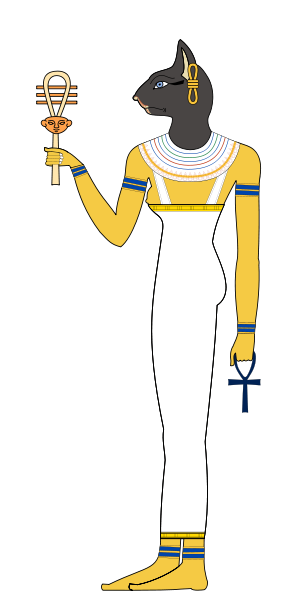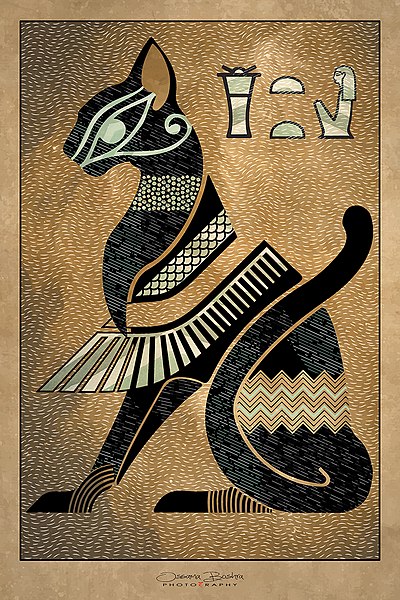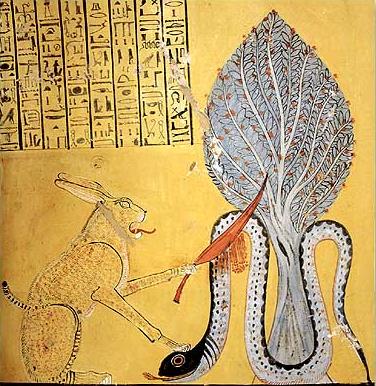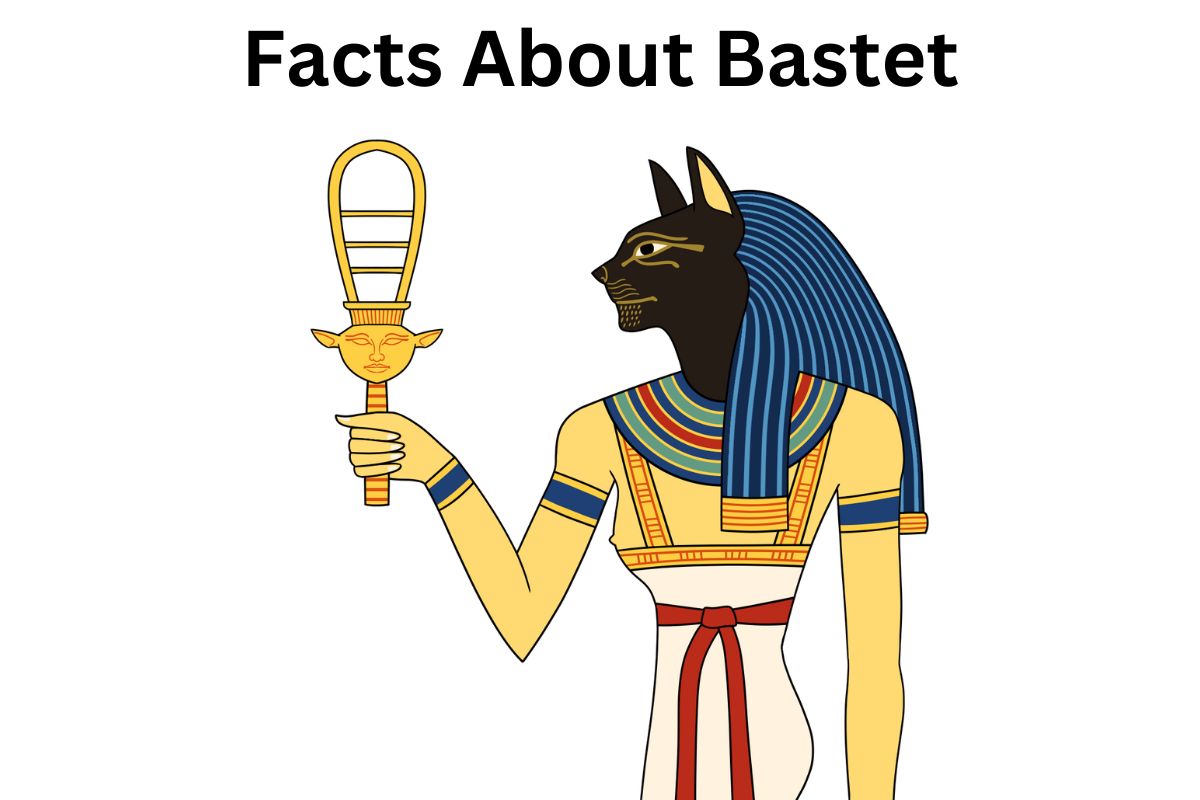Bastet, also known as Bast, is an ancient Egyptian goddess associated with home, fertility, and protection. Revered as a deity of the sun, the moon, and the hearth, Bastet was often depicted as a lioness or a woman with the head of a lioness.
Cats held a special place in her worship, as she was their patron goddess and believed to have the power to protect homes from evil spirits and diseases. Bastet was also associated with music, dance, and joy, and her annual festival, the “Bastet’s Feast,” was a grand celebration filled with music, dance, and elaborate processions.
Over time, Bastet’s role evolved, and she became more closely associated with domestic cats and took on a more benevolent and nurturing aspect.
While her worship declined with the decline of ancient Egyptian civilization, Bastet’s legacy endures as a symbol of femininity, protection, and feline grace in modern spirituality and popular culture.
Bastet Goddess Facts
1. Bastet, also known as Bast, is an ancient Egyptian goddess who was primarily associated with home, fertility, and protection
Bastet’s association with home, fertility, and protection made her a beloved and respected goddess in ancient Egypt. She was considered a guardian deity, watching over households and ensuring their well-being.
Egyptians believed that she had the power to ward off evil spirits, illness, and misfortune, making her an essential figure in their daily lives.

2. Bastet was often depicted as a lioness or as a woman with the head of a lioness
Bastet’s iconic representation as a lioness or a woman with the head of a lioness symbolized her qualities as a fierce and protective goddess. The lioness was revered for its strength, agility, and hunting prowess, traits that were attributed to Bastet as well. The imagery of a lioness with her cubs further emphasized her role as a nurturing and maternal figure.
3. Cats were highly regarded in ancient Egypt, and Bastet was their patron deity
Cats held a special place in ancient Egyptian society, and their association with Bastet elevated their status to a sacred level. Egyptians admired cats for their ability to hunt and protect homes from pests, such as mice and snakes.
They believed that cats possessed a spiritual connection to the divine and that they could channel the protective powers of Bastet. As a result, domesticated cats were cherished as household companions and were treated with great respect and care.
Harming or killing a cat, even accidentally, was considered a grave offense punishable by law.
The reverence for Bastet and cats extended beyond the domestic realm. Temples dedicated to Bastet often housed large populations of sacred cats, which were cared for by priests and priestesses.
These cats were considered living representations of the goddess and were venerated by devotees. The killing of a temple cat, even by accident, was believed to bring forth a severe punishment, potentially even death.
4. Bastet was also associated with the concept of fertility and was believed to assist in the conception and safe delivery of children
Bastet’s association with fertility was a significant aspect of her worship. Women who desired to conceive or have a successful pregnancy often turned to Bastet for assistance. They would visit her temples, offer prayers and offerings, and seek her blessings.
Bastet was believed to have the power to ensure the health and well-being of both the mother and the child throughout the process of pregnancy and childbirth. As a fertility goddess, she was also invoked during rituals and ceremonies related to conception and childbirth.

5. In addition to her protective and fertility-related roles, Bastet was also associated with music, dance, and joy
Music, dance, and joy were intimately connected to Bastet’s worship. She was considered a goddess of celebration and merriment. The sistrum, a musical instrument consisting of a metal frame with small metal discs that produced a jingling sound when shaken, was closely associated with Bastet.
It was played during religious rituals dedicated to her, as well as during festivals and processions. The rhythmic sounds of the sistrum were believed to please the goddess and bring her presence and blessings to the devotees.
6. Bastet had a strong connection to the sun god Ra and was often depicted as his eye or as a protective goddess associated with the sun’s rays
Bastet’s association with the sun god Ra further elevated her status and importance in Egyptian mythology. She was considered both a daughter and an eye of Ra, symbolizing her role as a protective deity associated with the sun’s rays.
The sun was a vital source of life and energy in ancient Egypt, and Bastet’s connection to Ra emphasized her ability to safeguard and preserve these life-giving forces.
As the Eye of Ra, she was believed to ward off evil and protect Ra from any threats or adversaries. This association also highlighted her connection to the sun’s warmth, light, and life-sustaining properties, aligning her with concepts of vitality and renewal.

7. During the annual festival of Bastet, known as the “Bastet’s Feast,” Egyptians would celebrate with music, dancing, and elaborate processions
The annual festival of Bastet, known as the “Bastet’s Feast” or “Bubastis Festival,” was one of the most important and widely celebrated events in ancient Egypt.
It took place in the city of Bubastis, where the main temple dedicated to Bastet was located. The festival was a grand affair filled with music, dance, and revelry.
People from all walks of life would participate in the festivities, which included processions with statues of Bastet, performances by musicians and dancers, and elaborate rituals conducted by priests and priestesses.
The festival provided an opportunity for people to express their devotion to Bastet and seek her blessings for a prosperous year ahead.
8. Over time, Bastet’s role and attributes evolved
Over time, Bastet’s role and attributes evolved in ancient Egypt. Initially associated with the lioness and depicted as a warrior goddess, she gradually transformed into a nurturing and protective deity. This shift was influenced by the increasing importance of home and family life in Egyptian society.
Bastet became associated with domestic cats, which were revered as her companions and seen as sacred animals. She came to symbolize protection, fertility, and joy. The changes in Bastet’s role reflect the adaptability of ancient Egyptian mythology to the evolving beliefs and cultural values of the time.
9. Bastet’s cult reached its peak during the 22nd Dynasty of ancient Egypt
The cult of Bastet reached its peak during the 22nd Dynasty of ancient Egypt. It was during this time that Bastet’s worship became particularly prominent, and numerous temples dedicated to her were built throughout the country.
The Temple of Bastet in Bubastis was the most famous and elaborate of these structures. The temple complex featured impressive statues, reliefs, and sacred enclosures dedicated to the goddess.
Pilgrims and devotees would visit the temple to make offerings, seek guidance, and engage in rituals to honor and connect with Bastet.
10. With the decline of ancient Egyptian civilization and the rise of Christianity, the worship of Bastet gradually diminished
As Egyptian civilization declined and new religious beliefs, such as Christianity, emerged, the worship of Bastet gradually diminished. The temples dedicated to her fell into disuse and disrepair over time. Many were eventually abandoned, and their grandeur faded away.
The rise of Christianity in Egypt led to a shift in religious practices, and the ancient Egyptian deities, including Bastet, gradually lost their prominence in mainstream worship. However, remnants of Bastet’s influence and symbolism can still be found in Egyptian culture today.
